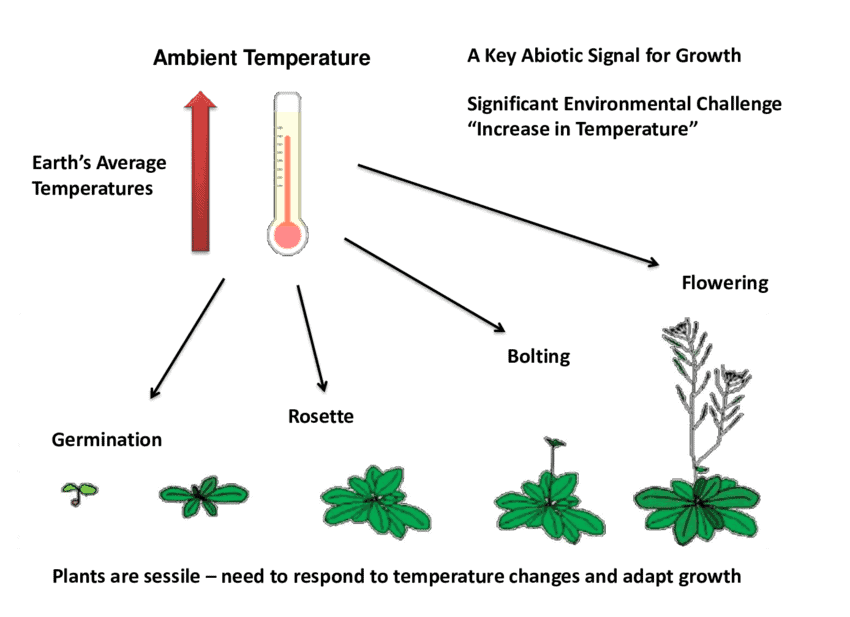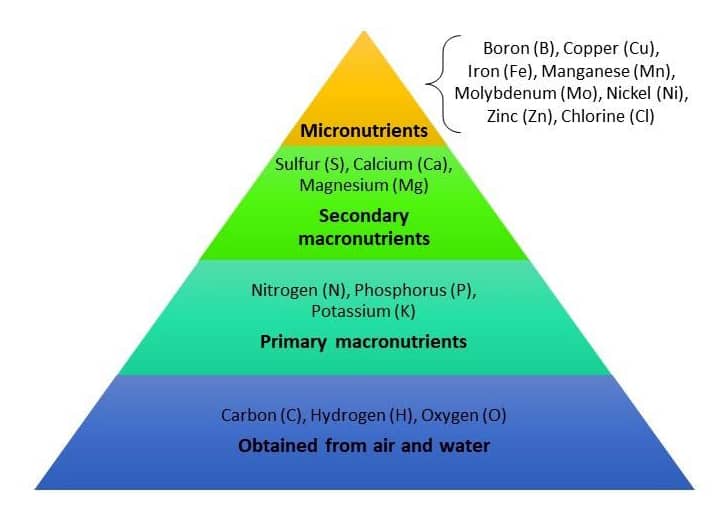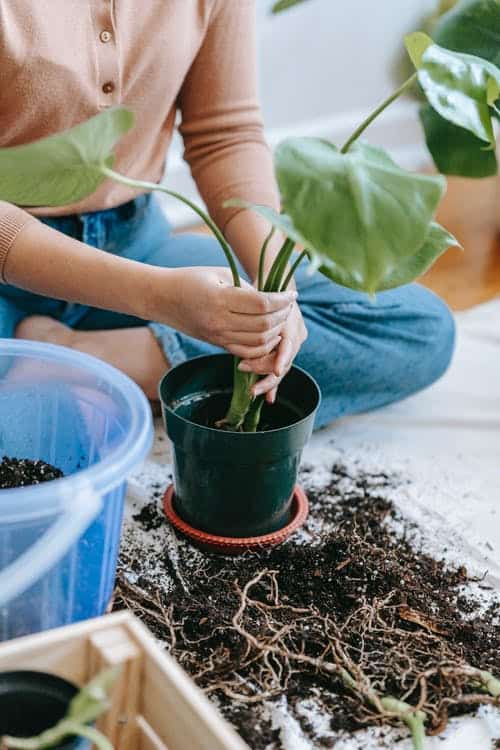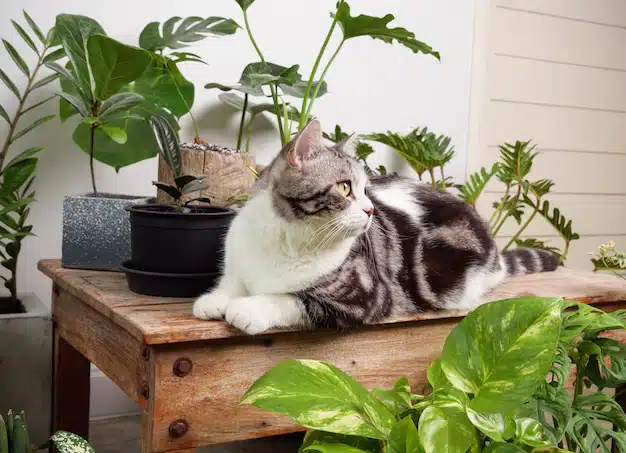The Anthurium Moodeanum is another attractive choice for those who enjoy leafy greenery. It is a peculiar and uncommon species of Anthurium.
Plant enthusiasts love this species for its vibrant colors and beautiful dark-colored foliage.
Keeping that concept in mind, we’ll show you how to care for your Anthurium Moodenaum.
Continue reading for a complete guide on the Anthurium Moodenaum plant’s care and propagation.
Table of Contents Show
Overview of Anthurium Moodeanum
Despite the fact that Anthurium Moodeanum is now being raised in some tropical regions around the world, it remains a rare variety due to its endemic nature and rare occurrence.
It is presumed that John Mood was the first to cultivate this plant in the Hawaiian region.
Here is a brief guide about the plant.
| Family | Araceae |
| Subfamily | Pothoideae |
| Genus | Anthurium |
| Origin | South America and Mexico |
| USDA Zones | 11 and 12 |
| Plant type | Climbing |
| Growth habitat | 10 to 12 feet tall |
| Foliage | Juvenile Burgundy to Mature Green |
| Flower | Spring to simmer: pink spathe and yellowish-green spadix |
| Toxicity | Toxic to both humans and animals |
Anthurium Moodeanum
Anthurium Moodeanum is a popular choice for indoor and outdoor planters because of its low maintenance requirements and attractive foliage.
As it has oval, heart-shaped leaves, it requires less attention than comparing those with more patterned and slender leaves.
| Requirement | Optimum Condition |
|---|---|
| Temperature | 70º – 90º Fahrenheit |
| Light | Medium to bright indirect light |
| Humidity | 50% or above |
| Water Requirement | Once or twice a week |
| Potting Mix | Well-draining, chunky, aerated soil. Top dress with sphagnum moss. |
| Fertilizer | Slow release Fertilizer in warm-season only |
| Re-pot | Once in two years |
| Propagation method | Stem cutting and Root division |
| Common Pests | Mealybugs, Spider mites and Aphids |
| Common Diseases | Bacterial Blight and Fungal Diseases |
Let’s discuss what is needed and best for growing Anthurium Moodeanum.
1. Bright Indirect Sunlight and Proper Location
Anthurium Moodeanum can thrive in a variety of light conditions; nevertheless, semi-shade or bright, indirect sunlight is ideal.
It can also sustain in low light conditions, but it will not flower. Position your Anthurium in a brightly illuminated area if you want to witness it flower.

It is also essential to rotate this plant in its location regularly for equal sunlight, resulting in even growth on both sides.
To ensure optimal growth potential, place the Anthurium Moodeanum less than 3 feet from a south-facing window.
If you live in a dark apartment and the light is insufficient for your Anthurium Moodeanum, consider investing in a good grow light. They are handy for plants in low-light environments.
Signs that Anthurium Moodeanum Needs More Light
- Sparse or Leggy Growth
- Plant leaning toward the light source
- Absence of new growth in the plant
- Plant producing small leaves
- Soil not drying out for weeks
Anthurium Moodeanum Showing Signs of Excessive Light
- Brown, dry spots on the leaves.
- Leaves turn creamy or yellow, particularly those closer to the light source.
- Yellowing may be pronounced in the leaf ends initially.
- Leaf yellowing may not impact the veins.
2. Weekly Watering
Anthurium Moodeanum thrives in evenly damp, soggy soil, but you should not over-water the plant. Before watering the plant, inspect the soil as it needs to dry fully.
If the soil on the Moodeanum is dry and breaking deeper than an inch, it’s time to water the plant.

You will have an issue if you over-water or underwater your plant. If you over-water the plant, the leaves will droop, and the root will begin to rot.
At the same time, browning leaves and hollowing stems indicate that your plant is dehydrated.
Watering your Anthurium Moodeanum once or twice a week is sufficient in the spring and summer.
The drying cycle of the soil in your region determines the watering pattern for Anthurium Moodeanum. The area where it is warmer with bright sunlight requires more water.
Watering the plant once every three weeks is sufficient to maintain its thriving during the fall and winter.
Tips for Watering your Anthurium Moodeanum
- Water the Anthurium Moodeanum less often but thoroughly.
- Allow the soil to dry fully before watering it again.
- Water the plant in the evening or early mornings for better results.
- To avoid diseases in the plant, keep the leaves as dry as possible.
- You must ensure that the water reaches the plant’s roots.
Treat Over-Watered Anthurium Moodeanum
- Stop watering your plant temporarily and improve drainage.
- Identify and treat root rot immediately.
- Consider changing the pot and soil to promote better drainage and faster soil drying.
- Provide increased ventilation and temperatures, and lower humidity.

Treat Under-Watered Anthurium Moodeanum
- Water your plant immediately.
- Make sure the water is running down the drainage holes before your stop.
- Place the plant in a shaded location for a few days.
- Check the plant regularly, and water it as per need.
3. Ideal Temperature
Anthurium Moodeanum is a tropical plant. It prefers sunny, warm weather during the day, with temperatures ideally ranging between 70 and 90 degrees Fahrenheit.
It can withstand temperatures at night that are roughly 10 degrees colder than daytime environments.
Avoid placing the Anthurium Moodeanum in spots where the temperature falls below 60 degrees Fahrenheit.

It will suffer cold damage if Anthurium Moodeanum is kept in a colder place for a more extended period or if the temperature continues to drop.
However, it can tolerate USDA Zones 11 and 12 and you can keep the plant outside in these areas even during the winter.
This is because these areas have enough sunlight and mild weather during that time of year.
But, bring the plant inside if there is snow or frost because the plant will not survive freezing winters outside.
If you feel like your plant is suffering during winters, you can invest in a good heating pad.
Also, you can cover the plant with a frost blanket or clear plastic bag in winter to avoid the risk of cold stress.
4. Humidity Level > 60%
Humidity is another essential aspect to consider when planting the Anthurium Moodeanum.
As Anthurium Moodeanum is a tropical region plant, it needs proper high humidity levels in the air.
Anthurium Moodeanum is adapted to higher humidity levels (more than 60 percent).

They can, however, grow reasonably well in dry regions (40-60 percent). As a result, average room humidity is adequate.
If you live in an extremely dry area, your plant may show signs like curling, drooping and liming of leaves.
In that case, you may use a digital hygrometer to determine the present state of humidity to keep track of humidity levels at your home.
Tips for Maintaining Ideal Humidity Levels
- Placing the plant in a terrarium can be a wise option. It helps prevent moisture from escaping, ensuring a high level of humidity.
- Group your houseplants to increase humidity around your plants in your home naturally.
- Use the plant mister, and mist the leaves a few times throughout the summer to maintain good humidity.
- An electric humidifier is the most convenient way to increase humidity for your Anthurium Moodeanum.
- For an easy way, transfer the plant to a humid location, such as the kitchen or bathroom.
- You can make a pebble tray. Place a tray of wet pebbles beneath the planter. As the water evaporates, it contributes by increasing the humidity.
Point to Note: When grouping your plants, make sure they do not have any diseases, as the diseases might spread to other plants.
Inspect your plants regularly to prevent leaves and stem rot, bugs, and fungal growth caused by high humidity.
5. Well-draining Soil
Anthurium Moodeanum prefers a light, airy nutrient soil with a pH of 6.5 as it is susceptible to root rot.
Light and airy soil will let enough air and water circulation at the root, which helps avoid the risk of over-watering, leading to root rot in Anthurium Moodeanum.

When making the potting mix, you must be careful to avoid excessive water retention and possibly root rot. Also, do not even over-compact the potting mix.
Potting soil, perlite, bark, charcoal, and sphagnum moss are the best materials to use when making a good soil mix, as perlite helps in drainage and the chunkier base allows for greater airflow.
How to Prepare an Ideal Anthurium Moodeanum Potting Mix?
Here’s how to make the perfect Anthurium Moodeanum potting mix at home.
- Take 30% Orchid mix,
- Mix 20% peat, Perlite and Pine Bark
- Top it with 10% sphagnum moss
Your plant will love it!
Few retail potting mixes that do wonders for your Anthurium Moodeanum.
6. Regular Fertilization
Anthurium Moodeanum does not require frequent fertilizer but enhances the foliage’s health and growth, and you can fertilize your plant in the growing season.
Anthurium Moodeanum is a light feeder that only requires fertilizer every 4-6 months.
This plant requires phosphorus to develop healthy blooms, therefore using a phosphorus-rich feed will help.
Growing seasons (spring and summer) are ideal for fertilization. But avoid fertilizing your plant in the winters as they do not require that additional nutritional boost in winter.
You should use slow-release fertilizer instead of basic liquid fertilizer. You will have to feed Anthurium Moodeanum every two weeks if you use a liquid fertilizer.

If you are using the liquid fertilizer, you need to dilute it to a fourth of its original strength.
To dilute the fertilizer, add 1/4 spoonfuls to a gallon of water. Then place it in your Anthurium’s already-watered substrate.
However, if you still want to show them, extra love, you may occasionally incorporate some natural organic supplements.
Eggshells: As eggshells are calcium-rich, they offer calcium to your plants.
Chicken/Fish Bones: Phosphorous is abundant in chicken and fish bones.
Vegetable By-Products: Vegetables are nutrient-dense. It can be the best natural feed for your plants after it decomposes.
Garlic and onion skins: High in potassium and can help with disease resistance.
Here are a few links to some commercial fertilizers that work like magic for Anthurium Moodeanum
- SUPERthrive VI30155 Plant Vitamin Solution
- Miracle-Gro 1016111 Advance Starter Kit
- Advanced Nutrients GL525050-12 Big Bud Liquid Fertilizer
You should be very careful when limiting the amount of fertilizer you give the Anthurium Moodeanum as both over and under fertilization impact the plant.
| Over Fertilization | Lack of Fertilization |
|---|---|
| Salt build up on the soil surface | Lack of phosphorus may lead to no bloom |
| Yellowing, wilting of the stem | Weak stem and pale foliage |
| Leaves will turn brown | Slow plant growth |
7. Growth Rate
Anthurium Moodeanum is a fast-growing plant. The average indoor Anthurium Moodeanum can grow about a few feet tall.
But outdoor ones can grow slightly taller as they have a wider surface area.
When the plant is young, the leaves are rich burgundy in color and progress to a deep green tint.
As the plant expands and the leaves grow larger, you may notice new and intriguing characteristics.
During the spring and summer, the blossoming season increases the attractiveness by producing distinctive pinkish flowers on tall stems.

However, the major attraction of the plant is the long, rich burgundy and vivid green foliage.
Once the plant has reached maturity, it can bloom resulting in your own Anthurium seeds.
8. Potting and Re-potting
Anthurium Moodeanums are plants that grow quickly.
Re-potting Anthurium Moodeanum will be required every 1 to 2 years due to their growth patterns.
You do not, however, need to clock it. Rather, every time you hydrate your plant, glance at the plant’s root ball and the base of the pot.
When roots start to emerge from the drainage holes, it is a sign that the plant is yearning for extra space.

When re-potting, resist the need to use a much larger planter. Instead, progressively increase the pot height (1 to 2 inches).
It is always a good idea to opt for clay or terracotta planters when potting or re-potting your Anthurium Moodeanum.
Plastic pots accumulate water, while natural pots tend to evaporate excess moisture and maintain air exchange.
Meanwhile, make sure that your pot has a few drainage holes at the button to drain out excess water.
Pro Tips: The best time to re-pot your Anthurium Moodeanum is during the start of the spring.
Make sure you refrain from re-potting your plant in the winter or autumn season as this will lead to a frail and weak plant.
Do give them the rest they deserve!
Step by Step Guide to Re-pot Anthurium Moodeanum
Step 1 – Remove the Plant
Tilt your new plant horizontally, carefully hold it by the stems or leaves, and press the bottom of the pot until it falls out.
Step 2 – Loosen the Roots
Carefully uncover the roots of the plant with your fingers. You can cut any extra-long thread-like roots, but make sure to leave the thicker roots at the plant’s base.

Step 3 – Remove Old Potting Mix
Discard one-third to one-half of the potting mix around the plant.
Your plant used up part of the nutrients in the present combination as it matured, so if you are potting it nonetheless, you will want to give it a fresh mix.
Step 4 – Re-pot the Plant
Place the plant you retrieved from the old pot on top of the new planter’s fresh layer of soil, making sure it is straight, and then sprinkle the potting mix around it until it is stable.
Step 5 – Water and Enjoy
Evenly distribute the potting soil on top and thoroughly water the re-potted plant. It is important to note that a newly re-potted plant does not require fertilizer.
Things to Keep in Mind After Re-potting
- Maintain your newly re-potted plant out of direct sunlight and extreme temperatures.
- Make sure it gets plenty of water. But do not over-water the plant.
- Before returning to your old maintenance routine, keep an eye on your plants for roughly two weeks.
9. Pruning and Grooming
The real kicker is that Anthurium Moodeanum does not require much pruning or upkeep. This is just another argument for why it is simple to maintain.

You can trim it every now and then to make it look the way you want it to or manage its size. On the other hand, pruning is all about getting rid of dead, diseased, or discolored leaves.
Ensure to prune your Anthurium Moodeanum only during warmer seasons, preferably during spring or summer.
But in case of dead or decaying leaves, you can snip them off anytime you see one.
Tips to Prune Anthurium Moodeanum Properly
- Look through your Anthurium Moodeanum, then start pruning from the top down.
- Eliminate any leaves that are discolored or decaying. Cut the faded or dead blooms all the way down to the stem’s base.
- To enhance the beauty of the plant, you can also trim stray leaves but leave at least three to five intact.
- Pull suckers from the base of Anthurium Moodeanum; else, they will drain the plant’s vitality, resulting in smaller flowers.
- Dull blades can shred and crush stems, making the plant more prone to disease and pests. It is recommended to use high-quality cutting equipment.
- Clean the cutting instruments with rubbing alcohol or a 10% bleach solution between each trim to minimize bacterial infection.
Toxicity of Anthurium Moodeanum
Anthurium Moodeanum is highly toxic to both animals and humans. The plant body is composed of calcium oxalate, which is highly responsible for the symptoms to follow after ingestion.
You will get a terrible burning sensation in your mouth if you or your pets consume them.

Blisters and swelling inside your mouth are possible side effects. It is possible that you will have trouble swallowing, and your voice will sound hoarse.
If you discover that your pets have consumed the plant, keep an eye on their symptoms. Or take them to a veterinary hospital right away.
Call the Pet Poison Helpline at 855-764-7661 or ASPCA Animal Poison Control Center at 888-426-4435 to know further steps.
Propagation Methods for Anthurium Moodeanum
Plant division and stem cuttings are the most convenient ways to propagate Anthurium Moodeanum at home.
This is a simple and convenient method for growing a new plant from a clone of an old one. But you also need to know how to propagate and take care of the plant.
Propagation by Stem Cutting
- Choose a healthy stem that is at least 4 to 6 inches long. Something with at least 2 to 3 leaf nodes is ideal.
- Use a sharp knife or scissors to produce clean cuts and sterilize your cutting instrument.
- Leave the cut end of the stem to callous after cutting it. After you make the cut, sap will stream out. Though the plant is poisonous, the sap is not irritating to the skin.
- For propagating the stem in water, you may alternatively go straight to a soil-filled pot. However, the soil-filled pot process is long and has a lower success rate.
- Replace the water in the glass of water regularly, ideally once a week, before it becomes dirty.
- Roots will emerge from the cut end of the stem after 15 to 21 days.
- You can transplant the plant into a pot once the roots are about half an inch long or longer. You can wait a little longer as well and enjoy the beautiful roots.
Propagating stem cuttings in water (Source: Pexels)
Propagation by Root Division
- You can create two to three young plants from a healthy and well-grown Anthurium Moodeanum.
- Begin by breaking the soil around the plant and gently removing it without damaging the roots.
- Now, cut the plant into two to three sections with a sterile scissor, retaining at least three stalks in each division. The plant’s roots are all knotted together into a ball. Split the roots for each section using your fingertips.
- Replant each piece in its proper location and enjoy adding it to your collection.
Propagation Of Plant From Plant Division (Source: Stocklib)
Post-Propagation Care Tips
- When transplanting into the soil, make sure to use a lightweight, well-draining nutrient solution.
- Use a spike or a small pole to support the cutting if it is unable to stand straight on its own.
- Once the top layer of soil has dried, water it and keep it damp. But don’t overdo it with the water.
- Position the pot somewhere bright indirect sunlight.
- After a few months, shoots should start to emerge.
Common Problems in Anthurium Moodeanum
The best method to maintain your Anthurium Moodeanum healthy is to give it the proper care and meet the parameters given above. Pests, though, can still be a concern.
And while no gardener wants to see them, you are bound to run across issues at some point during your gardening journey.
1. Common Pest
Anthurium Moodeanum is a pest-resistant plant. And, with good maintenance, including regular leaf wiping, you may never have to worry about bugs during the plant’s lifetime.
Nevertheless, like with other houseplants, there is no assurance that these pests will stay away.
As a result, you must continually be on the lookout for them and examine your plant.
In addition to good care, retaining the plant clean is another effective technique to keep pests at bay. This is particularly the case for large-leaved plants.
Mealybugs and Scales
The appearance of waxy coatings on the plant and black sooty mold that forms on the nectar generated by these bugs, yellowing, withering leaves, and twisted or stunted plant development are all indications of a scale or mealybug invasion.

Solution: Eliminate the mealybugs and scales with a cotton ball moistened with rubbing alcohol.
Rinse leaves with a powerful spray of water to expel bugs physically.
Aphids
Another sap-sucking bug, aphids, create sticky slime as well. They can target a wide range of plant parts, but they prefer sensitive, new growth, where they induce withering and deformation.

Solution: Most aphids will be dislodged by a forceful squirt of water.
Employ your bathroom sprayer or take your plant outside to water it off. Spraying with insecticidal soap or neem oil is also beneficial.
Preventive Measures
- Avoid grouping houseplants too frequently as the infected Plants can spread diseases to other plants.
- After misting, don’t keep the leaves damp because this can pests a friendly environment.
- Pests are usually drawn to plants with high nitrogen levels and moist soil, so do not overfertilize or overwater your plant.
- Follow a regular pattern when using insecticides to reduce the problem. It will only protect your plant for a few months after spraying it.
2. Common Diseases
Diseases, unlike bugs, are a little easier to avoid. While we may not be able to avoid all plant diseases, the most common cause is too much water.
After that, it is either underwatering or letting the plant dry out for too long. Both put the plant in a stressful condition, making it more vulnerable.
Fungal disease
Fungal diseases in Anthurium Moodeanum cause reddish-brown to black circular patches or spots on the leaf that cause noticeable irregular-shaped lesions or blistering.
Rhizoctonia fungi attack the roots and lower stems of plants, but it can also attack and spread in the upper leaf canopy under wet conditions.
Rhizoctonia can survive within the soil for years without a host plant.
The fungus produces small mats of tightly woven mycelia called sclerotia.

Solution: Dissolve one teaspoon of baking soda in one quart of water to make a standard baking soda spray.
To assist the liquid distribution and adhere to the leaves, add a few drops of insecticidal soap or liquid soap.
Apply potent fungicides like Medallion (fludioxonil) and Prostar (flutolanil) that effectively treat fungal diseases.
Bacterial Blight
Blight is a deadly illness that can develop when a plant is penetrated or injured. It also appears when the humidity level is too high.
Small water-soaked patches on the underside of leaves are the first signs of common bacterial blight. The patches grow bigger and stick together, turning dark, dry, and fragile.

These patches are distinguished by a faint yellow border that surrounds lesions.
Solution: If you are dealing with bacterial blight, a mixture of copper and mancozeb-containing fungicides may be effective.
Apply fungicides two to three times as leaves develop at seven to ten-day intervals.
3. Yellowing Leaves
When the Anthurium Moodeanum foliage turns yellow, it is a sign that you have over-watered the plant.
If the yellowing of the leaves is caused by root rot, you will need to start over by planting a new Anthurium Moodeanum.
Solution: If you follow the recommended watering schedule, the Anthurium Moodeanum will thrive.
4. Spots on leaves
Spots on rotting leaves indicate that your Anthurium Moodeanum is receiving too much direct sunlight. The intense sunlight fries the leaves, giving the impression that they are rotting.

Solution: Simply position the plant near north-facing windows, and it will flourish once more.
Preventive Measures
- Keep your plant and soil free of pests and diseases by following a suitable watering schedule.
- When your Anthurium is regularly exposed to water mists, it becomes vulnerable to disease. Eliminate excessive misting.
- As a preventative approach, check for any fungal and bacterial signs once a week.
- Always clean the tools, vessels, and potting soil when potting, repotting, or cutting your plant to keep it safe from diseases.
Frequently Asked Questions about Anthurium Moodeanum
Is it possible to grow Anthurium Moodeanum outside?
In zones 10 through 12, Anthuriums Moodeanum can be cultivated outside.
But, it is necessary to grow them in the shade because they are woodland plants, and the plants cannot survive direct sunlight.
Why is my Anthurium Moodeanum not growing?
The Anthurium Moodeanum relies heavily on light for its growth. Inadequate lighting is the most common cause of Anthurium development problems.
Why is Anthurium Moodeanum so expensive?
Anthurium Moodeanum is not common in home gardens and is a difficult tropical plant to come by. Because of these two factors, it is more pricey.
Also, watch the full video for more information,
Conclusion
Now that you are very familiar with all the dos and don’ts related to Anthurium Moodeanum head to the nearby plant store and get one for your living space.
Follow this guide to keep an eye out for plant pests, fungal or bacterial illnesses, and a sickly appearance on your Anthurium Moodeanum.
Leave a comment below to let us know if you’re having trouble with pretty Anthurium.
Happy Gardening!


